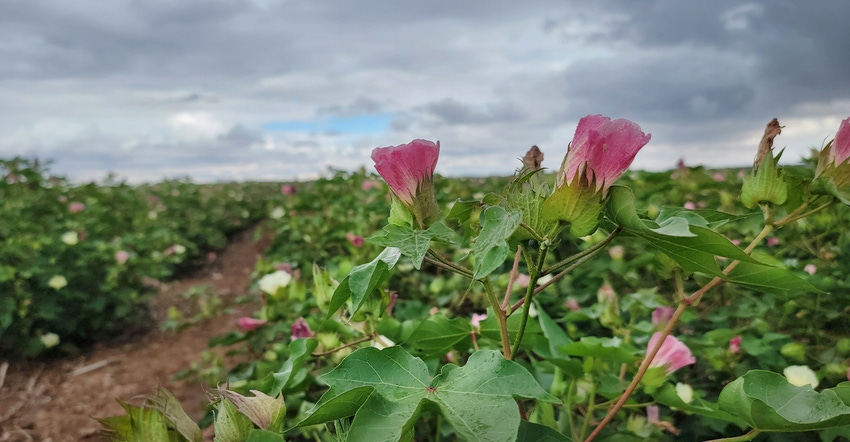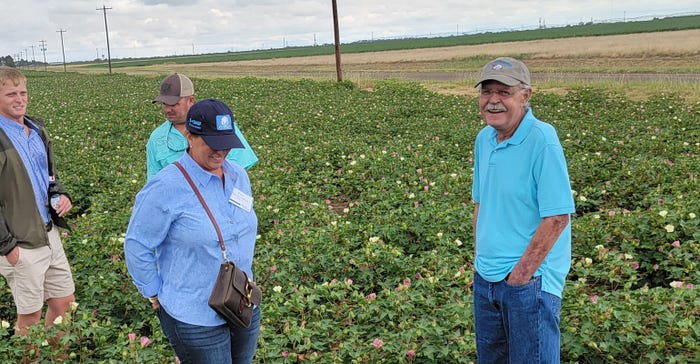
Sam Stanley is optimistic about the future of row crop agriculture on the Texas High Plains.
He’s optimistic in spite of losing some 30% of irrigation well production during the 2011 drought. “That production has never come back,” says Stanley, who farms in Hockley County. “Over the last two or three years, wells on some farms fell more than that. Well production has for sure gone down. But irrigation capacity is mostly holding.”
He admits to being concerned about declining water resources, but he’s convinced that technology will find a way.
 Sam Stanley, right, visits with producers touring his field during the Southeast/Mid-South National Cotton Council Producer Information Exchange tour. (Photo by Shelley E. Huguley)
Sam Stanley, right, visits with producers touring his field during the Southeast/Mid-South National Cotton Council Producer Information Exchange tour. (Photo by Shelley E. Huguley)
“Technology has already given us ways to use water better,” he says. “We can do more with less. I don’t know what comes next.
“Some people in this area are concerned about water going away, but I believe this country will continue to grow crops because technology will change again. I can’t see what’s coming but it will.”
Subsurface drip
For now, he’s tapping into currently available technology to use water as efficiently as he can.
“Our whole operation is in subsurface drip. That’s the most efficient way to use water.”
He says concerns about subsurface drip irrigation system longevity have not been realized. “We installed our oldest systems in 2003. That’s almost 20 years. Our newest systems have been in from 3 to 12 years.”
He says subsurface irrigation systems’ longevity rivals pivots. “Some systems south of us, down around St. Lawrence, north of Midland and Odessa, have been in for 40 years. We no longer have concerns over how long the systems will last—with good maintenance.”
Maintenance, he adds, is not burdensome. “We use an end-of-season acid treatment of sulfuric acid and follow that with a washout to get the system clean. Some farms have manganese and use peroxide in the water to keep the systems open. “Maintenance is pretty simple, not hard.”
Crop management
Crop management also plays a role in water use efficiency.
“We experiment all the time with new dings, looking at products that improve the ability to bring water to the surface better. Nothing works every time. We apply biologicals in the seed furrow when we plant to help decay organic matter in soils. That helps a lot.
“We apply a lot of plant growth regulators to help manage vegetation and not waste resources. We want to produce fruit instead of growing a big plant. We are aggressive with that.”
He uses some cover crops, but not across the board.
“We plant cover in areas with problems. But cover crops take moisture to grow, and about half the time we get enough winter moisture to produce cover and not hurt the cash crop. Other times, we lose moisture to grow the cover and sacrifice yield on the cash crop.
“I think cover crops have great value to put organic matter in the soil.”
Reduced tillage also conserves organic matter. “We’ve been 100% no-till for 14 years; this year makes 15. We do not till at all. After harvest, we spray for winter weeds, cut stalks, and leave the dead litter on top of the ground. We plant the new crop into that residue.
“In areas where we can’t preserve much trash or dead litter, where the soil does not grow as big a plant and does not make enough cover, we plant a cereal rye cover crop.”
Stanley says no-till has changed the way the fields look. “Some 14 years ago, we had the prettiest farm around, but we were not doing it right. We didn’t have the technology, the weed control herbicides to plant no-till. Now, we have better planters and better systems.”
He says rotation has a place, “but the rotation crop has to be profitable. Over the years, we’ve rotated with corn on some acres. That rotation strategy is okay as long as corn prices are higher than cotton. Mostly, we stay with cotton.”
Stanley says improved varieties also play a role in water efficiency. “Newer varieties will produce good yields with less water. Better varieties are being advanced at a fast pace.”
That’s one of the reasons for Stanley’s optimism. He says things like variety improvements, more efficient irrigation systems, and better crop management practices will keep irrigated crop production viable on the Texas High Plains.
Tier-4 engine emissions control
He adds that the equipment they use now includes tier-4 engine emissions control. “We are not polluting the environment; we are not emitting carbon into the air with equipment. We don’t get recognized for that.”
He says the emission control technology is expensive, about $60, 000 per piece of John Deere machinery.” It’s required by law, so we have to do it, but we don’t get credit for doing our share.”
See, Southeast, Mid-South producers tour Texas South Plains
Stanley says 2022 has been a “hard year, but it’s turning out better than I ever thought. It’s not the best crop, but I am excited to see how it turns out. Prices are good.”
What comes next? “I expect to see new techniques, new varieties, new systems. I don’t know what’s coming, but I believe we will always have irrigated land, to some degree, in this region.”
He’s looking forward to finding new ways to farm sustainable, to conserve the land. “We can’t do this, we can’t be successful, and not love the land,” he says.
For more articles about water management, click on the following links:
About the Author(s)
You May Also Like






